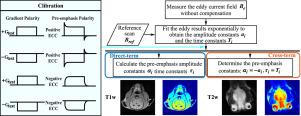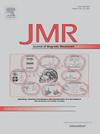基于递推公式的0.255 T MRI自动梯度涡流补偿方法
IF 1.9
3区 化学
Q3 BIOCHEMICAL RESEARCH METHODS
引用次数: 0
摘要
梯度线圈通过产生快速开关磁场实现空间编码,在磁共振成像(MRI)系统中起着至关重要的作用。然而,这些时变场会在周围的导电结构中产生涡流,导致梯度场畸变和成像伪影。在这项研究中,我们提出了一种在现场可编程门阵列(FPGA)平台上实现的自动涡流补偿方法。该方法采用线性梯度和B0涡旋场的迭代校正公式,实现实时补偿。为了提高计算效率,本文还介绍了一种新的预强调单元布局。与传统的补偿技术相比,所提出的基于fpga的补偿方案在实现简单性和系统稳定性方面有显著改进。实验结果表明,当测试梯度为20 mT/m时,直接项和交叉项涡流场的残余量降至0.02%以下,相当于4 μT/m。此外,采用B0补偿线圈将B0涡流场抑制到0.1 μT以下。这些改进有效地降低了多层梯度回波(GRE)伪影图像中的重影伪影。在各种成像序列中,包括t1加权(T1w)和t2加权(T2w)协议,进一步验证了该方法的鲁棒性。本文章由计算机程序翻译,如有差异,请以英文原文为准。

Recurrence formula-based automatic gradient eddy current compensation method for a 0.255 T MRI system
Gradient coils play a critical role in magnetic resonance imaging (MRI) systems by enabling spatial encoding through generating rapidly switching magnetic fields. However, these time-varying fields induce eddy currents in surrounding conductive structures, leading to gradient field distortions and imaging artifacts. In this study, we propose an automatic eddy current compensation method implemented on a field-programmable gate array (FPGA) platform. The approach employs iterative correction formulas for both linear gradient and eddy fields, enabling real-time compensation. To enhance computational efficiency, a novel layout for the pre-emphasis (PE) unit is also introduced. Compared to conventional compensation techniques, the proposed FPGA-based solution offers significant improvements in implementation simplicity and system stability. Experimental results demonstrate that the residual direct- and cross-term eddy current fields are reduced to below 0.02%, equivalent to 4 , for a test gradient of 20 mT/m. Furthermore, the eddy field is suppressed to below 0.1 when a compensation coil is employed. These improvements effectively reduce ghosting artifacts in multi-slice gradient-echo (GRE) phantom images. The robustness of the method is further validated across various imaging sequences, including T1-weighted (T1w) and T2-weighted (T2w) protocols.
求助全文
通过发布文献求助,成功后即可免费获取论文全文。
去求助
来源期刊
CiteScore
3.80
自引率
13.60%
发文量
150
审稿时长
69 days
期刊介绍:
The Journal of Magnetic Resonance presents original technical and scientific papers in all aspects of magnetic resonance, including nuclear magnetic resonance spectroscopy (NMR) of solids and liquids, electron spin/paramagnetic resonance (EPR), in vivo magnetic resonance imaging (MRI) and spectroscopy (MRS), nuclear quadrupole resonance (NQR) and magnetic resonance phenomena at nearly zero fields or in combination with optics. The Journal''s main aims include deepening the physical principles underlying all these spectroscopies, publishing significant theoretical and experimental results leading to spectral and spatial progress in these areas, and opening new MR-based applications in chemistry, biology and medicine. The Journal also seeks descriptions of novel apparatuses, new experimental protocols, and new procedures of data analysis and interpretation - including computational and quantum-mechanical methods - capable of advancing MR spectroscopy and imaging.

 求助内容:
求助内容: 应助结果提醒方式:
应助结果提醒方式:


